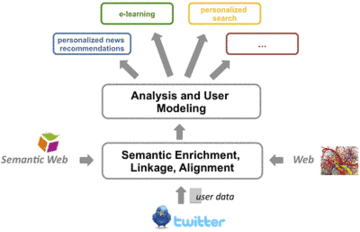[About] [Services] [Datasets] [Publications]
About
How can micro-blogging activities on Twitter be leveraged for user modeling and personalization? TweetUM is the Twitter-based User Modeling Framework developed by the Web Information Systems group. It features a set of strategies that allow for semantic enrichment of Twitter messages (tweets) and relates tweets to external (Semantic) Web resources. TweetUM offers functionality such as entity recognition or discovery of relations between entities. Based on enriched tweets, it provides a variety of user modeling strategies that are applied for various applications such as personalized news recommendations.
Some TweetUM highlights:
- semantic enrichment by linking tweets with (Semantic) Web resources
- user modeling with temporal dynamics
- TUMS Web service makes TweetUM features available to other Web applications
- personalisation based on TweetUM: news recommendations, personalized faceted search
Services
TUMS: Twitter-based User Modeling Service
The Twitter-based User Modeling Service (TUMS) allows end-users to inspect Twitter-based profiles and enables other applications to re-use these profiles. TUMS is therefore interesting for other services on the Social Web as it enables them to consume Twitter-based profiles in RDF format. Profiles can be used for personalization and are particularly useful for other applications that suffer from sparsity problems (e.g. services that cannot collect sufficient data about their users) and services that are interested in "realtime" or very fresh profile information.
- Details on TUMS: http://www.wis.ewi.tudelft.nl/tums/
- TUMS demo: http://wisserver.st.ewi.tudelft.nl:8080/um-twitter-service/
GeniUS: A Generic User Modeling Library for the Social Semantic Web
GeniUS is a generic topic and user modeling library for the Social Semantic Web that enriches the semantics of social data and status messages particularly. Given a stream of messages, it allows for generating topic and user profiles that summarize the stream according to domain- and application-specific needs which can be specified by the requesting party.
- Details on GeniUS: http://www.wis.ewi.tudelft.nl/genius/
Datasets
With TweetUM, we have monitored - since November 15th 2010 - more than 20,000 users over a period of more than four months. Overall, we collected more than 30 million tweets and processed them with the TweetUM enrichment and user modeling pipeline. Subsets of this dataset are available online: datasets
Selected Publications
- Fabian Abel, Qi Gao, Geert-Jan Houben, Ke Tao. Analyzing User Modeling on Twitter for Personalized News Recommendation. In Proceedings of International Conference on User Modeling, Adaptation and Personalization (UMAP2011), Girona, Spain, July 2011. [bib, pdf, slides(pdf)]
- Fabian Abel, Qi Gao, Geert-Jan Houben, Ke Tao. Semantic Enrichment of Twitter Posts for User Profile Construction on the Social Web. In Proceedings of 8th Extended Semantic Web Conference (ESWC2011), Heraklion, Crete, Greece, May 2011. [bib, pdf]
- Ilknur Celik, Fabian Abel, Geert-Jan Houben. Learning Semantic Relationships between Entities in Twitter. In Proc. of International Conference on Web Engineering (ICWE), Paphos, Cyprus, Springer, 2011. [bib, pdf, slides(pdf)]
- Ke Tao, Fabian Abel, Qi Gao, Geert-Jan Houben. TUMS: Twitter-based User Modeling Service. In Proceedings of International Workshop on User Profile Data on the Social Semantic Web (UWEB), colocated with ESWC2011, Heraklion, Crete, Greece, May 2011. [bib, pdf, slides(pdf)]
- Fabian Abel, Qi Gao, Geert-Jan Houben, Ke Tao. Analyzing Temporal Dynamics in Twitter Profiles for Personalized Recommendations in the Social Web. In Proceedings of 3rd International Conference on Web Science (WebSci'11), Koblenz, Germany, June 2011. [bib, pdf]
- Qi Gao, Fabian Abel, Geert-Jan Houben, Ke Tao. Interweaving Trend and User Modeling for Personalized News Recommendations. In Proceedings of International Conference on Web Intelligence (WI2011), Lyon, France, August 2011. [bib, pdf, slides(pdf)]
- Ilknur Celik, Fabian Abel, Patrick Siehndel. Towards a Framework for Adaptive Faceted Search on Twitter. In Proc. of International Workshop on Dynamic and Adaptive Hypertext (DAH), ACM Hypertext, Eindhoven, the Netherlands, 2011 [bib, pdf]

